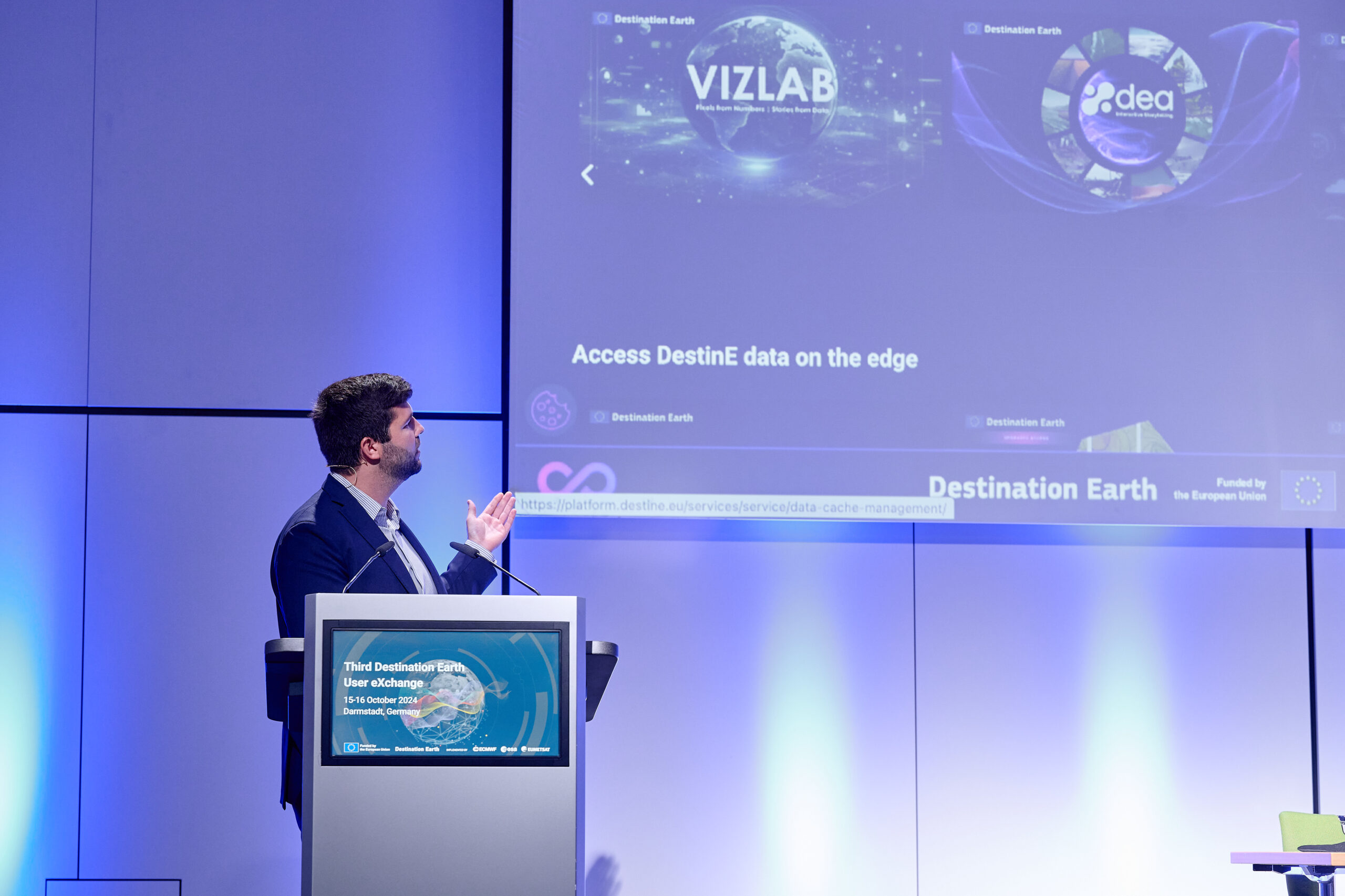Users at the heart of the 3rd DestinE User eXchange

The 3rd User eXchange meeting, hosted in October by EUMETSATEuropean Organisation for the Exploitation of Meteorological in Darmstadt and co-organised with ECMWFEuropean Centre for Medium-Range Weather Forecasts More and the European Space Agency (ESAEuropean Space Agency) , was an opportunity to share progress with the Destination Earth (DestinE) community and listen to users’ requests and remarks. The resulting report, which is now available online, lists the key takeaways from the event and summarises what users can expect from DestinE in the near future.
After the welcoming speeches and maintaining what is now a tradition of the User eXchange meetings, the three entities entrusted to implement DestinE briefed the audience on the development of the different components within the system.
Director for DestinE at ECMWFEuropean Centre for Medium-Range Weather Forecasts More Irina Sandu explained how the Climate and Extremes digital twins, developed by ECMWFEuropean Centre for Medium-Range Weather Forecasts More and other partners across Europe, boost our ability to better respond and adapt to challenges posed by climate change and extreme events. Irina talked about the current state of the digital twin component, while also touching on the next steps and forthcoming developments.

Implemented by EUMETSATEuropean Organisation for the Exploitation of Meteorological, the Data Lake is an essential component of DestinE that references and provides seamless access to Digital Twin data and a large number of external data spaces. EUMETSAT’s DestinE Programme Manager Lothar Wolf gave an update on the status, key achievements and services of the Data Lake.

An important goal of the event was to bring users together and offer them the opportunity to explore the DestinE PlatformSelf-standing DestinE system component, interfacing with the More. Following its launch in October, the platform is now available to users and is a central pillar of the European Space Agency’s (ESAEuropean Space Agency) contribution to DestinE. It is an open, flexible and secure cloud-based solution that provides access to DestinE data, tools, applications and services for evidence-based decision-making.
After the opening speeches on the first day, Space Business Development Manager Alexis Longuet (Serco) gave a very well-received live demonstration of the DestinE PlatformSelf-standing DestinE system component, interfacing with the More, featuring an overview of the web portal’s features and services from a user’s perspective. Serco also hosted further training sessions, where users were able to gain hands-on experience with DestinE’s data access services.

Tristan Goss, Head of Engineering at data science company Earthwave, echoed the feedback of many of the participants regarding the benefits of the training: “I needed to understand some of the differences between the tools [on the platform], and this session helped very much with that.” Earthwave is looking to provide services on DestinE, and Tristan was happy that the session included comprehensive coverage of both existing and required features.
On day two, users remained the central focus of the event. The ‘Interacting with the DestinE PlatformSelf-standing DestinE system component, interfacing with the More and Edge Services’ session sought to help the user community understand how to interact with the DestinE PlatformSelf-standing DestinE system component, interfacing with the More.
“We wanted to address the practicalities of getting to grips with the platform so that engagement is enhanced and the user journey is as smooth as possible,” explains Earth Observation Data Process Engineer Inés Sanz Morere (ESAEuropean Space Agency). “With my colleagues from EUMETSATEuropean Organisation for the Exploitation of Meteorological and Serco, we covered the simple key steps of registering, accessing and onboarding new services to support both the community’s needs and the DestinE initiative’s objectives.” Inés and her fellow moderators also showcased several of the platform’s available services, including the Edge ServicesNear-data processing services on the DEDL. More provided by the DestinE DataEarth-system monitoring and prediction system output as prov More Lake.
Another key moment for users was the DestinE Community Forum. This lively interactive session gave users an opportunity to discuss and share their perspectives on DestinE’s evolution and, crucially, how it could be improved. Drawing on feedback from a pre-event survey, the session fostered a dynamic environment for exploration of the topic from various angles, encouraging dialogue and showcasing the diversity of opinions.
“Users and their needs and challenges really are at the heart of DestinE,” said ESAEuropean Space Agency Use Cases Technical Officer Claudia Vitolo (ESAEuropean Space Agency). “With DestinE, we want to push the boundaries of how we monitor our planet, but to do that we need a strong and engaged community. That is why events like these User eXchanges are so important, and I’m confident that the info sessions, open discussions and sharing of views that this third gathering has afforded will empower our users to fully exploit the platform’s possibilities.”
Make sure you don’t miss important DestinE updates.
Photos in this piece have been provided by EUMETSATEuropean Organisation for the Exploitation of Meteorological/Axel Gaube.

